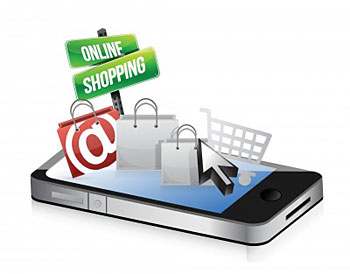By Ron Kustek, Business Instructor Cabrillo College
 You may have a business that is 100% online, or you may own a ‘brick and mortar’ storefront, that has customers walking through the door. But more than likely you’re a combination business, one that operates face-to-face with people and also one that is able to sell online 24/7 as well.
You may have a business that is 100% online, or you may own a ‘brick and mortar’ storefront, that has customers walking through the door. But more than likely you’re a combination business, one that operates face-to-face with people and also one that is able to sell online 24/7 as well.
If you’ve not heard the term “mCommerce” or “Mobile Commerce” before – it’s exactly what you think it is – eCommerce buying for everyone on-the-go using a mobile device such as a smartphone or tablet. Forget the days when your beautiful website appeared in full grandeur on a desktop computer monitor or huge laptop screen. How you look and how easy you’re able to conduct business on small screens is much more important today, and will be in the near future.
Do I need an app for that?
 Don’t think you need to create a separate app in addition to your website in order to serve your mobile customers. Your website can be designed and built to best serve the mobile user. Keep in mind that people don’t like to scroll down on their mobile devices, so the display of either your appointment calendar or items for sale should focus on the title, a brief description and the price.
Don’t think you need to create a separate app in addition to your website in order to serve your mobile customers. Your website can be designed and built to best serve the mobile user. Keep in mind that people don’t like to scroll down on their mobile devices, so the display of either your appointment calendar or items for sale should focus on the title, a brief description and the price.
Mobile doesn’t provide the visual real-estate for lengthy descriptions or intricate backgrounds. Thus, the page design of your website should be built with the ability to dynamically serve pages to mobile devices. To understand if your site is the best it can be for mobile commerce, consult with your web design and optimization marketing company.
Another thing to keep in mind is that Google reports over 20% of queries through its mobile app are for voice search — which is a different functionality than what used to be your website’s focus on keywords for search optimization to be found organically (meaning, without paying for Adwords). If your website isn’t “mobile optimized” it is likely that you are missing out on being found by those voice search instead of typing what they’re looking for into a search box.
Social Selling
 Facebook has recently been in the news about their marketing practices. Don’t think that Facebook exists as just a way for people to stay connected and post their pretty pictures of their vacation, kids or plates of food (why people do this, I have no idea).
Facebook has recently been in the news about their marketing practices. Don’t think that Facebook exists as just a way for people to stay connected and post their pretty pictures of their vacation, kids or plates of food (why people do this, I have no idea).
Facebook is a marketing and advertising platform where over 2 billion people monthly are visiting, posting, and buying. When someone clicks a link on Facebook and buys a product, the average order value is $55. Facebook “converts” nearly 2% of its visitors, which is the rate at which a Facebook visitor clicks-thru an ad, video, etc., going on to make a purchase. The quick math is that Facebook generates over $2.2 billion in sales monthly for its business partners.
That’s also why Facebook bought Instagram — because people on smartphones were sharing pictures and experiences, and are now buying a tremendous amount of products and services directly through Instagram. Facebook, Pinterest and Instagram have very powerful tools for businesses to learn how to generate sales through their platforms, with easy to understand instructions, as well as very affordable programs to cost-effectively reach your target customer.
Remember, if you’re not posting regularly on social platforms like Instagram, you’re not as relevant as your competitors who are.
People are mobile and constantly engaged with their smartphones, so being regularly shared and talked about online is critical for your business. People are impatient and often impulsive, wanting to buy what they see — now.
Whether it’s a customer sharing a picture of an item they bought from you, or your own company sharing an event or announcement on Instagram, you must stand out, be interesting, and above all, be relevant in today’s mobile-sharing-buying world.
•••
Ron Kustek is a business instructor at Cabrillo College teaching Entrepreneurship, Marketing, Advertising, Small Business and General Business Management.



